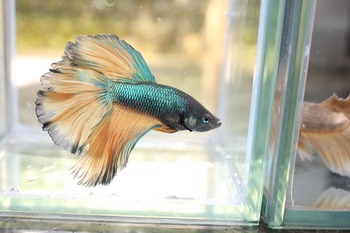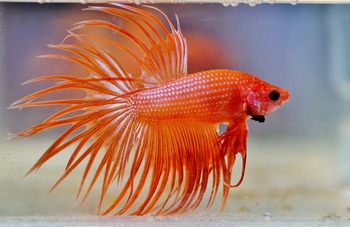Betta fish, also known as Siamese fighting fish—are undeniably beautiful and fascinating creatures. Their vibrant colors and flowing fins make them a favorite in home aquariums. But behind those dazzling displays lies a complex behavior pattern, especially when it comes to cohabitation. One of the most common questions among new and even seasoned fish keepers is: Can male and female bettas live together?
The short answer? Not permanently. While there are some exceptions, housing male and female bettas together is usually not recommended due to high risks of aggression, territorial disputes, and stress-induced injuries or death, particularly from the male.
In this article, we’ll dive deeper into betta fish behavior, when (if ever) it’s safe to house them together, how to recognize warning signs, and tips to minimize conflict if a short introduction is necessary—such as during breeding.
Understanding Betta Behavior: Why Aggression Happens
Before you even consider putting a male and female betta in the same tank, it’s important to understand why aggression is so common.
1. Territorial Instincts
Male bettas are famously territorial. In the wild, they claim a small area—usually in rice paddies or slow-moving waters—and fiercely defend it from intruders, especially other bettas. This instinct carries over to aquarium life.
When a male betta sees another fish—especially one that resembles a betta, including females—his instincts kick in. He’ll flare his gills, fan his fins, and may chase or attack the perceived threat.
2. Male vs. Female Aggression Levels
While male bettas are the more notoriously aggressive, female bettas aren’t exactly peaceful either. They can be feisty, especially when stressed, during breeding, or when establishing a pecking order (which is why female sororities are also tricky to manage).
That said, males are usually the primary aggressors in mixed-gender situations and can easily injure or kill a female if she cannot escape his attacks.

So, Can They Ever Live Together?
In most cases: No.
In general, male and female bettas should not live together permanently. According to other expert sources:
- Males often view females as threats once courtship is over.
- Females can become stressed, leading to illness or death.
- Even in larger tanks, aggression isn’t guaranteed to be avoidable.
However, there are very specific exceptions where short-term cohabitation may be attempted—usually during breeding.
The Breeding Exception: Temporary Cohabitation
The only common scenario where male and female bettas are intentionally housed together is during breeding. But even this is not without risks and should be done with careful planning.
Steps for Controlled Breeding:
- Conditioning the Pair:
Before introducing the fish, both male and female should be conditioned with high-quality foods like brine shrimp or bloodworms for 1-2 weeks. This prepares them physically for the spawning process. - Use a Divider or Breeding Box:
Initially, separate the male and female using a divider or place the female in a breeding box within the male’s tank. This allows them to see each other and begin courtship behaviors (like the male building a bubble nest) without direct contact. - Observe Behavior Carefully:
When the female displays vertical breeding stripes and the male is actively nest-building, you can try a short supervised introduction. - Post-Spawning Separation:
Once eggs are laid and fertilized, the female must be removed immediately. The male will guard the bubble nest and may turn on the female if she stays in the tank.
Bonus Tip:
Use a tank with a lid—during courtship or aggression, bettas may jump, and an uncovered tank could lead to an unfortunate accident.
“But I’ve Seen Videos Where They Lived Together!”
Yes, you might come across some YouTube videos or social media posts showing a male and female peacefully swimming in the same tank. And sure, there are exceptions—but they’re rare, and even then, the dynamic can change suddenly and violently.
Bettas have distinct personalities. Some are unusually mellow, and others are outright tyrants. But unless you’ve got a large, heavily planted tank, endless patience, and the ability to monitor them constantly, it’s not a risk worth taking.
What About in Large Tanks with Hiding Spots?
Some aquarists have experimented with keeping a male and female together in a very large, heavily planted tank (typically 20 gallons or more) with lots of hiding places. The theory is that more space reduces stress and gives the female places to retreat if needed.
But this is not a reliable solution. Even in these ideal setups:
- Males can still hunt down the female if they feel threatened or overly dominant.
- There’s no guarantee of peaceful coexistence.
- Injuries and stress can still occur, often when you’re not watching.
So while it may work for a few lucky cases, it’s far from a safe or recommended practice for most hobbyists.
Factors That May Influence Compatibility (Temporarily)
Some fishkeepers report better luck when the following factors align:
- Chilled-out male temperament: Some males are naturally less aggressive, but this is rare.
- Older, more mature female: Females who are larger and more experienced may stand up better to male aggression.
- Heavily planted tanks: More plants and caves can help reduce visibility and stress.
- Close monitoring: Daily or even hourly checks are needed if attempting cohabitation.
But again, these are exceptions—not rules. Betta fish are highly individual, and what works for one tank might spell disaster in another.
Why Risk Isn’t Worth It for Most Owners
Even with proper care and setup, the emotional toll of seeing your bettas injured—or worse—isn’t worth the risk for most fishkeepers. Bettas thrive on their own and don’t need companions to be happy.
In fact, many male bettas live healthier and longer lives in solo tanks where they can patrol their territory without stress or conflict.
A Note on Stress
It’s easy to forget, but stress is a big deal for bettas. Just because a fish isn’t visibly injured doesn’t mean they’re okay. Chronic stress from bullying or even just the presence of an aggressive tank mate can cause:
- Weakened immune systems
- Loss of color or appetite
- Clamped fins
- Lethargy and poor health
- Shortened lifespan
So even if your male and female bettas aren’t visibly fighting, the constant tension can silently wear them down.

Better Alternatives for Multi-Fish Tanks
If you’re looking to keep more than one betta, here are some safer alternatives:
1. Female Sorority Tank
A group of 4–6 female bettas can sometimes live together peacefully, but it requires careful introduction, plenty of space (at least 20 gallons), and lots of hiding spots. Keep in mind, sororities can still have hierarchy disputes.
2. Divided Tanks
A sturdy, transparent divider in a large tank allows you to keep a male and female betta in the same water system but in separate compartments. They can see each other without physical contact, which often reduces boredom without risk.
3. Community Tanks with Peaceful Species
Some bettas—especially females—can live in community tanks with non-aggressive species like:
- Neon tetras
- Ember tetras
- Corydoras catfish
- Kuhli loaches
- Mystery snails or ghost shrimp
Always research compatibility, provide enough space, and monitor for signs of aggression.
FAQs: Male and Female Betta Cohabitation
Q: Can I keep a male and female betta together if they seem to get along at first?
A: No. Bettas may seem fine at first, but aggression often develops over time. It’s not worth the long-term risk to the female’s health.
Q: What signs should I watch for if I try housing them together temporarily?
A: Watch for fin nipping, excessive chasing, hiding, stress stripes, or lethargy. Separate immediately if you see these signs.
Q: Will a larger tank prevent fighting?
A: A larger tank with hiding spots can reduce aggression but does not eliminate the risk. Territorial instincts are hardwired in bettas.
Q: Can I introduce them slowly to help them bond?
A: Slow introductions can reduce initial aggression, but they do not guarantee long-term compatibility. Always keep a backup plan ready.
Q: What about using tank mates instead of bettas for companionship?
A: Yes, especially for female bettas. Peaceful tank mates like rasboras, kuhli loaches, or ghost shrimp are often better choices than another betta.
Q: Is it cruel to keep a betta alone?
A: Not at all. Bettas are solitary by nature and actually thrive when they have a tank to themselves with plants, toys, and regular care.
Q: Can bettas get lonely?
They don’t experience loneliness the way we do. What they do need is mental stimulation—plants to explore, a mirror to flare at occasionally, and a calm, clean environment.

Final Thoughts: Better Safe Than Sorry
While the idea of pairing a male and female betta may seem romantic or natural, the reality is much more complicated—and often dangerous. Their natural instincts for aggression and territory make long-term cohabitation risky and usually harmful, especially for the female.
Unless you’re an experienced breeder with the right setup and time to monitor constantly, it’s best to keep your bettas separate. They’ll live longer, healthier lives—and you’ll avoid the heartbreak of an unexpected fight.
When in doubt, remember: Just because you can doesn’t mean you should.
Bettas are stunning, intelligent, and full of personality. Give them the peaceful, stress-free environment they need—and they’ll reward you with vibrant color, active swimming, and years of enjoyment.






